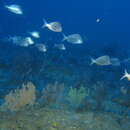fr
noms dans le fil d’Ariane


Die Slinger (Chrysoblephus puniceus) is 'n vis wat slegs aan die ooskus van Suid-Afrika en Mosambiek voorkom. In Engels staan die vis bekend as slinger seabream.
Die vis is roserig of pienk van kleur met 'n blou strepie onder elke oog. Dit kan tot 40 cm lank word en weeg dan 4 kg.
Die vis kom voor in koraal- en rotsriwwe in water wat 20 –130 m diep is. Hulle word ook gesien saam met die Selakant by Sodwanabaai. Die onvolwasse vissies kom water wat 12 – 60 m diep is voor. Hule eet krappe, garnale, vis en soöplankton. Die wyfies skiet kuit gedurende die somer aan die KwaZulu-Natal kuslyn.
Die Slinger (Chrysoblephus puniceus) is 'n vis wat slegs aan die ooskus van Suid-Afrika en Mosambiek voorkom. In Engels staan die vis bekend as slinger seabream.
Chrysoblephus puniceus és un peix teleosti de la família dels espàrids i de l'ordre dels perciformes.[2][3]
Pot arribar als 85 cm de llargària total.[4]
Es troba des de les costes de Moçambic i Madagascar fins a les de Sud-àfrica.[4]
Chrysoblephus puniceus és un peix teleosti de la família dels espàrids i de l'ordre dels perciformes.
Chrysoblephus puniceus ('golden-eyed purple'), also known as the slinger seabream, is a species of sea bream from southern African waters, ranging from Zavora, Mozambique to Coffee Bay in the Eastern Cape, from the shallows to a depth of 130m.[1] Slingers are the only protogynous hermaphrodite in the Natal area,[3] with females becoming male at approximately 5 years[1] or 38 cm.[4] Subsequently, these now-male individuals can often grow to 55 cm in length.[5] In theory, this reproductive system leads to most offspring being fathered by just a few individuals, which would lead to decreased genetic diversity and inbreeding depression. However, comparisons with the ecologically similar (but gonochoric) santer sea bream indicate similar levels of genetic diversity and effective population size over historic timescales.[6]
It is an important commercial species, making up 25-50% of the total commercial catch in KwaZulu-Natal.[7] Because large individuals are targeted by commercial fishing, and the only males are large, there was growing concern that the stock could be wiped out in the early 1990s,[8] and indeed the stock was severely depleted by fishing by the late 1990s, but has since shown a 30% recovery in biomass.[9]
Chrysoblephus puniceus ('golden-eyed purple'), also known as the slinger seabream, is a species of sea bream from southern African waters, ranging from Zavora, Mozambique to Coffee Bay in the Eastern Cape, from the shallows to a depth of 130m. Slingers are the only protogynous hermaphrodite in the Natal area, with females becoming male at approximately 5 years or 38 cm. Subsequently, these now-male individuals can often grow to 55 cm in length. In theory, this reproductive system leads to most offspring being fathered by just a few individuals, which would lead to decreased genetic diversity and inbreeding depression. However, comparisons with the ecologically similar (but gonochoric) santer sea bream indicate similar levels of genetic diversity and effective population size over historic timescales.
It is an important commercial species, making up 25-50% of the total commercial catch in KwaZulu-Natal. Because large individuals are targeted by commercial fishing, and the only males are large, there was growing concern that the stock could be wiped out in the early 1990s, and indeed the stock was severely depleted by fishing by the late 1990s, but has since shown a 30% recovery in biomass.
Chrysoblephus puniceus es una especie de peces de la familia Sparidae en el orden de los Perciformes.
• Los machos pueden llegar alcanzar los 85 cm de longitud total.[1]
Se encuentra desde las costas de Mozambique y Madagascar hasta las de Sudáfrica.
Chrysoblephus puniceus es una especie de peces de la familia Sparidae en el orden de los Perciformes.
Chrysoblephus puniceus Chrysoblephus generoko animalia da. Arrainen barruko Sparidae familian sailkatzen da.
Espezie hau Agulhasko itsaslasterran aurki daiteke.
Chrysoblephus puniceus Chrysoblephus generoko animalia da. Arrainen barruko Sparidae familian sailkatzen da.
Chrysoblephus puniceus is een straalvinnige vissensoort uit de familie van zeebrasems (Sparidae).[1] De wetenschappelijke naam van de soort is voor het eerst geldig gepubliceerd in 1908 door Gilchrist & Thompson.
Bronnen, noten en/of referenties隆背麗眼鯛為輻鰭魚綱鱸形目鱸亞目鯛科的其中一種,分布於西印度洋區,從莫三比克、馬達加斯加至南非海域,棲息深度10-100公尺,體長可達85公分,棲息在沿海海域,屬肉食性,以軟體動物、甲殼類、蠕蟲等為食,可做為食用魚。
隆背麗眼鯛為輻鰭魚綱鱸形目鱸亞目鯛科的其中一種,分布於西印度洋區,從莫三比克、馬達加斯加至南非海域,棲息深度10-100公尺,體長可達85公分,棲息在沿海海域,屬肉食性,以軟體動物、甲殼類、蠕蟲等為食,可做為食用魚。